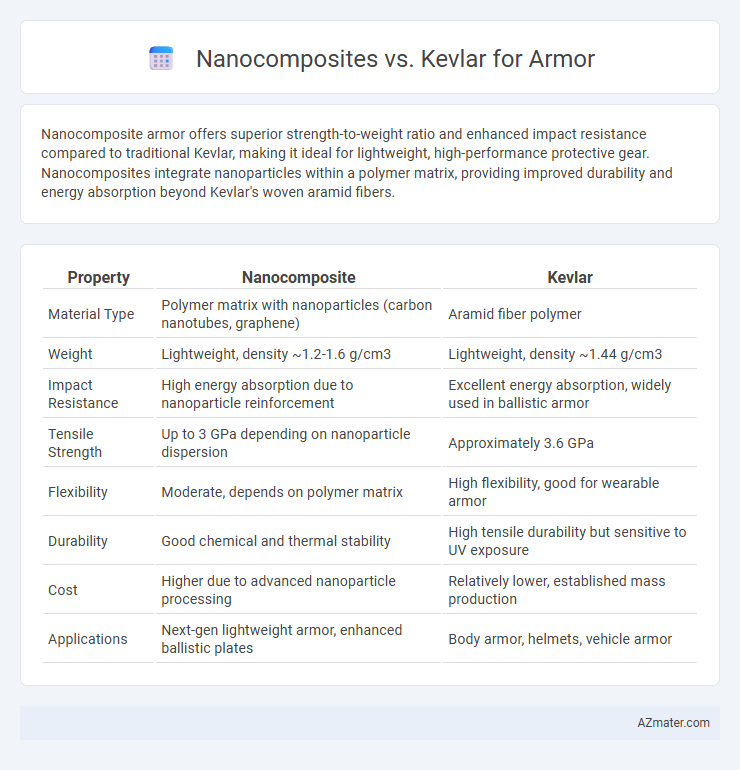Nanocomposite armor offers superior strength-to-weight ratio and enhanced impact resistance compared to traditional Kevlar, making it ideal for lightweight, high-performance protective gear. Nanocomposites integrate nanoparticles within a polymer matrix, providing improved durability and energy absorption beyond Kevlar's woven aramid fibers.
Table of Comparison
| Property | Nanocomposite | Kevlar |
|---|---|---|
| Material Type | Polymer matrix with nanoparticles (carbon nanotubes, graphene) | Aramid fiber polymer |
| Weight | Lightweight, density ~1.2-1.6 g/cm3 | Lightweight, density ~1.44 g/cm3 |
| Impact Resistance | High energy absorption due to nanoparticle reinforcement | Excellent energy absorption, widely used in ballistic armor |
| Tensile Strength | Up to 3 GPa depending on nanoparticle dispersion | Approximately 3.6 GPa |
| Flexibility | Moderate, depends on polymer matrix | High flexibility, good for wearable armor |
| Durability | Good chemical and thermal stability | High tensile durability but sensitive to UV exposure |
| Cost | Higher due to advanced nanoparticle processing | Relatively lower, established mass production |
| Applications | Next-gen lightweight armor, enhanced ballistic plates | Body armor, helmets, vehicle armor |
Introduction to Advanced Armor Materials
Nanocomposite materials incorporate nanoscale fillers such as carbon nanotubes or graphene into polymer matrices, enhancing strength, flexibility, and impact resistance, making them promising candidates for next-generation armor. Kevlar, a synthetic aramid fiber, has long been a standard due to its high tensile strength, lightweight nature, and proven ballistic resistance in personal protective equipment. Comparing these materials involves analyzing mechanical properties, weight efficiency, and energy absorption capabilities to determine the optimal solution for advanced armor design.
Understanding Nanocomposites
Nanocomposites for armor integrate nanoscale fillers like carbon nanotubes or graphene into polymer matrices, significantly enhancing mechanical strength, stiffness, and impact resistance compared to traditional materials. These nanoscale reinforcements distribute stress more effectively and improve energy absorption, providing superior ballistic protection with reduced weight. In contrast, Kevlar relies on tightly woven aramid fibers offering high tensile strength but generally falls short in stiffness and weight efficiency relative to advanced nanocomposite formulations.
Overview of Kevlar: Composition and Properties
Kevlar, a para-aramid synthetic fiber, is composed of long-chain poly-paraphenylene terephthalamide molecules arranged to provide exceptional tensile strength and thermal stability. Its high strength-to-weight ratio, excellent impact resistance, and durability make it a standard material in personal armor applications. Kevlar's molecular structure allows it to absorb and disperse energy efficiently, contributing to its widespread use in ballistic protection and body armor.
Mechanical Strength and Impact Resistance
Nanocomposites offer superior mechanical strength due to their enhanced matrix-filler interactions, resulting in improved stiffness and tensile properties compared to traditional Kevlar fibers. The nano-scale reinforcement in nanocomposites significantly increases impact resistance by effectively dissipating energy and reducing crack propagation under high-velocity impacts. Kevlar remains popular for its proven ballistic performance, but nanocomposites provide a promising upgrade in armor technologies through enhanced durability and weight reduction.
Weight and Flexibility Comparison
Nanocomposite armor offers significantly reduced weight compared to Kevlar, enhancing mobility without compromising protection. Its flexible polymer matrix allows greater adaptability and contouring to the body, unlike Kevlar's denser woven fibers which tend to limit flexibility. The improved weight-to-strength ratio in nanocomposites makes them an optimal choice for lightweight, flexible ballistic armor solutions.
Ballistic Performance and Protection Levels
Nanocomposite materials exhibit superior ballistic performance compared to traditional Kevlar due to their enhanced energy absorption and higher tensile strength at the nanoscale, resulting in increased resistance to penetration and improved blunt force trauma mitigation. Kevlar fibers provide reliable protection with high tensile strength and flexibility but can be outperformed by nanocomposites that integrate nanoparticles such as graphene or carbon nanotubes for added durability and lightweight construction. Protection levels for nanocomposite armor often surpass those of Kevlar-based systems, achieving higher National Institute of Justice (NIJ) threat ratings while maintaining lower weight, making them ideal for advanced ballistic armor applications.
Durability and Environmental Resistance
Nanocomposite armor exhibits superior durability due to its enhanced tensile strength and resistance to deformation compared to traditional Kevlar, making it ideal for high-impact scenarios. Its engineered matrix provides exceptional environmental resistance, maintaining performance under extreme temperatures, humidity, and chemical exposure. Kevlar, while highly effective against ballistic threats, tends to degrade faster when exposed to UV radiation and moisture, limiting its long-term environmental durability.
Manufacturing and Cost Considerations
Nanocomposite armor leverages advanced materials like carbon nanotubes and graphene, resulting in lighter weight and enhanced ballistic resistance but involves complex manufacturing processes with high precision and specialized equipment. Kevlar, a well-established aramid fiber, benefits from streamlined production techniques and lower manufacturing costs due to large-scale industrial capacity and established supply chains. Cost considerations favor Kevlar for budget-conscious applications, while nanocomposites command premium pricing justified by superior performance and innovation in armor technology.
Emerging Trends in Armor Technology
Nanocomposite armor materials exhibit superior impact resistance and lightweight properties compared to traditional Kevlar, driven by advancements in nanoparticle dispersion and matrix reinforcement techniques. The integration of carbon nanotubes and graphene within polymer matrices enhances ballistic protection while maintaining flexibility, marking a significant evolution in armor technology. Research in hybrid systems combining nanocomposites with Kevlar fibers is accelerating, aiming to optimize energy absorption and improve multi-hit performance in next-generation protective gear.
Future Outlook: Nanocomposites or Kevlar for Armor?
Nanocomposites exhibit significant potential for future armor applications due to their enhanced strength-to-weight ratios, superior thermal stability, and ability to be engineered at the molecular level for tailored ballistic performance. Kevlar remains a proven material with well-established manufacturing processes and reliability across diverse combat scenarios, but its limitations in weight and flexibility drive interest in next-generation materials. Advancements in nanofiller dispersion and scalable production methods suggest nanocomposites could surpass Kevlar by offering customizable protection, reduced bulk, and integration with smart armor systems.

Infographic: Nanocomposite vs Kevlar for Armor
 azmater.com
azmater.com